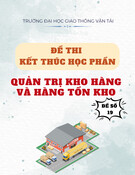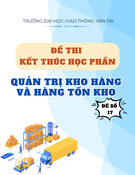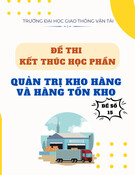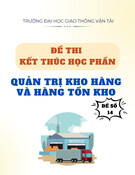
* Corresponding author
E-mail address:mcheshmberah66@gmail.com (M. Cheshmberah)
© 2019 by the authors; licensee Growing Science, Canada
doi: 10.5267/j.uscm.2018.10.003
Uncertain Supply Chain Management 7 (2019) 227–236
Contents lists available at GrowingScience
Uncertain Supply Chain Management
homepage: www.GrowingScience.com/uscm
An integrated framework (CTSR-BWG) for outsourcing decisions in a marine manufacturing firm
Mohsen Cheshmberaha*, Reza Rahbinb and Maliheh Eftekharia
aDepartment of Industrial Engineering, Malek Ashtar University of Technology, Isfahan, Iran
bDepartment of Industrial Engineering, Amir Kabir University of Technology, Tehran, Iran
C H R O N I C L E A B S T R A C T
Article history:
Received June 29, 2018
Accepted September 30 2018
Available online
October 6 2018
One of the most important questions in outsourcing management is to decide on the allocation
of the activities, processes or services either from the inside or from the outside of the
organizations through outsourcing operations. It is necessary to determine the factors
influencing outsourcing decision making as well as their impacts on decisions. In this paper,
the existing approaches and models and their related criteria are studied and the necessary
criteria are explored based on different conditions in marine manufacturing industries. These
criteria are categorized in four dimensions; namely Capacity, Technology, Strategy and
financial, and Risk called CTSR. After determining the weights of the criteria based on paired-
wise comparisons, the related calculations are carried out using PROMETHEE method.
Finally, a Black, White, Gray (BWG) analysis is executed to determine whether a candidate
should be outsourced or not.
ensee Growin
g
Science, Canada
by
the authors; lic9© 201
Keywords:
Outsourcing
Decision aiding
PROMETHEE
Marine
1. Introduction
During the past few decades, the traditional thinking in which the value chain activities took place
inside of organizations has been replaced by an organized and integrated network in which fewer
activities are accomplished done by the companies. On this basis, those activities that create value
should only be made internally and the rest must be outsourced as much as possible (Georgantzas,
2001). Adam Smith believes that a family manager never makes anything at home that costs more than
buying it (Bageri, 2008). Organizations are always looking for new strategies to develop their
competitive advantage. outsourcing is one of these strategies that can lead to more organization
competitiveness through reducing and controlling operating costs, focusing on core competencies,
utilizing skilled professionals not available inside the organizations, improving quality, etc. (Bertolini,
et al., 2004; Nayak, et al., 2007; Al-Kahtani, 2018). Understanding opportunities and challenges, and
in other words, identifying and analyzing outsourcing risks (Hessami, 2018) and determining the
effective criteria for outsourcing decision making are important, and lack of understanding can damage
the organizations; In outsourcing literature, there are various risks such as disclosing key information

228
and strategic directions, disclosing research and development projects and new ideas, elimination of
competitive advantage, etc. (Motadel, et al., 2011).
Understanding the advantages and disadvantages of outsourcing deepens our perception of the
necessity of properly determining the criteria and making the right decision for outsourcing. These
benefits include cost savings, reducing investment costs, increasing cash, converting fixed to variable
costs, improving quality, increasing speed, increasing flexibility, access to the latest technology and
infrastructure, access to skills and talents, increasing staffing activities, increasing focus on core
competencies, assigning activities or processes that are difficult to manage, learning from competitors,
resource release, responsiveness and better management, increasing transparency, risk sharing, etc.
(Agrawal, et al., 2016; Nakhaee, et al., 2008).
Disadvantages and risks of outsourcing include hidden costs, reduced flexibility, poor contract or
supplier selection, loss of knowledge and information and skills, loss of control, loss of core
competencies, supplier dependency, loss of customers and opportunities, uncertainty, environmental
change, damage to staff morale, conflict of interests, security implications, etc.(Bageri, 2008;
Cheshmberah, et al., 2009). Obviously, in order to properly manage outsourcing in an organization,
there is a need for a clear process, where one of the components of this outsourcing management
process, is the important step of deciding outsourcing for each activity (Cheshmberah, et al., 2014).
Outsourcing decisions at their higher levels should be considered strategic decisions so that these
decisions would have a key impact on the survival and durability of an organization (especially startup
companies) (Bustamante, 2018).
2. Literature review
Outsourcing decision-making in primary research is also referred to as “make or buy” decisions; in
preliminary studies, outsourcing decisions were initially based on costs, the most famous example of
which is Coase theorem (transaction cost economics); the matter for Coase theorem is that the use and
benefit from the market may come along with waste of money. During a service or product purchasing,
if the costs are too high, reliance on the inside of organization is more appropriate (Aubert, et al., 2004).
In Williamson's transaction cost theory (1975), transaction costs are the only outsourcing criterion
(Cánez, et al., 2000; Miltenburg, 2003). Outsourcing decision-making can be based on important
aspects such as “transaction cost theory” and “resource-based view” approach (Sharma, et al., 2015;
Bustamante, 2018). Prahalad and Hamel (1990) argued the relationship between core competency and
outsourcing. They considered core competency as collective learning in the organization, especially in
how to coordinate different production skills and integrate multiple technology streams (Prahalad, et
al., 1990). Venkatesan (1992) put forward an approach to the American Cummins Inc., and proposed
the idea of link between product differentiation, family component analysis, and manufacturing
capability as a way to make an outsourcing decision.
Welch and Nayak (1992) completed Venkatesan’s work. Their framework improved the traditional cost
analysis approach in terms of strategic and technological factors in the decision making process. In
addition, factors such as the competitive advantage of process technology, process maturity and
position of the competitors’ process were taken into account in the final supply decision (Welch, et al.,
1992). Probert (1996) tried to improve previous research by presenting a four-stage process to make or
buy. The various stages in this methodology are initial business evaluation, internal-external analysis,
strategic options assessment and optimal strategy selection. Probert used the strategic “make or buy”
methodology for six (6) manufacturing businesses, and reported the effectiveness of this methodology.
Padillo and Daibi (1999) also looked at the outsourcing with a few criteria. They developed a seven-
step multi-criteria decision methodology for assessing make or buy strategies which included four
factors of maximizing competitive strategic performance, minimizing risk, maximizing financial
performance, maximizing management performance, simultaneously. In this model, various methods

M. Cheshmberah et al. / Uncertain Supply Chain Management 7 (2019)
229
such as composite planning and analytical hierarchy process (AHP) (Saaty, 1987) were also used. Fill
and Visser (2000) succeeded in proposing a combination of the outsourcing decision framework. They
examined factors such as strategic factors, organizational structure and culture and cost (Fill, et al.,
2000).
Tayles and Drury (2001) provided a model for supporting make-or-buy decision-making, relying on
the strategic items and cost of investment. Fine et al. (2002) presented a model in which economic
value added and strategic value added for the outsourcing decision were used. In the economic value
added, factors such as costs, revenues, assets and the structure of competitive cost, and in strategic
value added, customer importance, rate of technology change, competitive position of the company,
capability of the supply base and product architecture were considered.
Ball (2003) presented a balanced decision matrix as a tool to assess the suitability of library services
for outsourcing. In this matrix, the outsourcing decisions were evaluated based on factors such as cost
of capital, number of suppliers, company strategies and service quality. Van Water and Van Peet (2006)
presented an outsourcing decision-making model that has a more strategic focus and has a structure
that allows the use of the AHP technique to reduce the complexity of the decision-making process.
Milecová et al. (2010) emphasized outsourcing decision-making to consider hidden costs. These costs
include the cost of outsourcing monitoring, outsourcing management, current transaction cost in
outsourcing (including contract costs, time costs, etc.) and costs related to return of investment. In
addition to costs, it emphasizes internal capabilities. It also emphasizes the assessment of risk analysis
and management. Cheshmberah et al. (2011a) considered the four dimensions of core competency,
technology, information risk and economic dimension (total cost) in a study on a manufacturing
company in aerospace industry. Cheng et al. (2012) used the Analytic Network Process (ANP) to create
an outsourcing assessment framework and evaluated four dimensions (economic, political, technology,
and vision of organization). Motadel et al. (2011) categorized main effective factors in outsourcing as
strategic importance of the project (including the contribution of the project in achieving the
organization’s main goals, the amount of project benefit from the strategic resources of the
organization, the degree of confidentiality of the project information, the importance of the project for
the future of the organization), the project characteristics (including the level of project expertise,
project complexity), the supplier characteristics (including customer confidence, technology ability,
supplier's organizational capability, flexibility, time saving), the organizational characteristics
(including employee expertise, financial ability, experience), and the cost (including the transaction
cost, the cost of doing activity within the organization).
Cheshmberah et al. (2011) studied the impact of product life cycle on the importance of outsourcing
decision-making criteria (Cheshmberah et al., 2011b). Attari et al. (2012) classified the criteria
influencing outsourcing decision making to secondary criteria, control measures and their effective
indicators, and presented a model based on the ANP (Niemira & Saaty, 2004) and fuzzy DEMATEL
techniques (Wu & Lee, 2007) for outsourcing decision making in a car manufacturing company. The
control criteria include quality, delivery, power, staff, cost of production and work processes, and
secondary criteria include compliance with standards, average outsourcing replacement time, quality
management system, timely delivery and other metrics. Tjader et al. (2014) presented a new approach
based on the Balanced Scorecard (BSC) and the ANP process, based on customer, organizational
learning and development and financial indicators and (internal) operations. These indicators include
subsets based on the scorecard approach.
Modaka et al. (2018) used an integrated BSC and AHP fuzzy approach (Aikhuele & Turan, 2017) for
outsourcing decision making in Indian coal mines. Also, the same team in another paper used the
combination of BSC and ANP to make outsourcing decisions in Indian coal mines (Modaka, et al.,
2018). Various criteria mentioned in the subject matter have been used to develop a preliminary list of
criteria on the case study.

230
4. Research methodology and data collection
Firstly, in this paper, attempts have been made to classify the criteria used in the subject literature, and
then, based on the research methodology, the criteria that are appropriate to the requirements of the
case study are to be explored; Table 1 shows the criteria classification.
Table 1
Categorizing Effective Criteria for outsourcing Decision Making
Strategy & risk
management
Supplier capability Cost
Attributes of
activity/process/product
Internal capability
Information risk (strategic,
technical, security, etc.)
Flexibility (volume, lot
size, technical, etc.)
outsourcing process
management costs
Product architecture
sufficiency of internal
capacity
Protecting organization'
know how
Supply in crisis Cost saving(s)
Technical
Attractiveness
organizational
Learning and growth
Risks of employee
(motivation, focus, etc.)
sufficiency of supplier'
capacity
Financial Attractiveness
Internal technological
capability
Strategic dependency
Supplier' technological
capability
Deepening employees'
knowledge and skills
Strategies & policies
Supplier' financial
capability
Due to the limited number of experts in the organization (designers, chief of staffs, project managers,
managers of quality assurance and procurement experts), 30 employees assisted in collecting the
required data. The questionnaire was classified according to the Likert scale and the respondents were
asked to determine the compliance of each of the criteria with the requirements and the conditions of
their organization; according to the investigations conducted by the academic and organizational
experts, the formal and content validity of the questionnaire was examined. In this way, 10
questionnaires were submitted to 10 related specialists and after problem solving and final
confirmation, they were used for data collection. To determine the reliability of the questionnaire,
Cronbach's alpha method was used and SPSS statistical software was used for statistical analysis. The
Cronbach's alpha value of the prepared questionnaire is 0.751, which indicates that the reliability of the
questionnaire is desirable.
4.1. Normality test
Kolmogorov-Smirnov test was used to study the normality of the data. In all tests, the statistical
hypotheses are assumed as (H0: Data are normally distributed, H1: Data are not normally distributed).
Table 2
Results of normality test
Hypothesis test Kind of test Dist. p-value K–S test Components
T-test Parametric Normal 0.332 0.946 Supplier capability in crisis
T-test Parametric Normal 0.1081.208 financial capability of supplier
Binomial Nonparametric Non-normal0.0061.713 Technological capability of supplier
BinomialNonparametric Non-normal0.0331.432 Technical flexibility of supplier
T-test Parametric Normal 0.0181.533 Volume flexibility of supplier
Binomial Nonparametric Non-normal0.0041.716 Sufficiency of supplier' capacity
T-test Parametric Normal0.0801.270 Cost saving
T-test Parametric Normal0.0131.591 Costs of outsourcing management
Binomial Nonparametric Non-normal0.0261.475 Product architecture
T-test Parametric Normal0.1641.118 Technical attractiveness (candidate)
T-test Parametric Normal0.3550.928 Financial attractiveness (candidate)
Binomial Nonparametric Non-normal0.0371.414 Sufficiency of internal capacity
T-test Parametric Normal0.0861.255 Organizational Learning and growth
T-test Parametric Normal0.0291.457 Risk of technical information leakage
Binomial Nonparametric Non-normal0.0021.892 Risk of security information leakage
Binomial Nonparametric Non-normal0.0171.545 Risk of strategic information leakage
T-test Parametric Normal0.1721.108 Risk of know how losing
Binomial Nonparametric Non-normal0.0221.501 Organization's weakness in fulfilling its obligations
Binomial Nonparametric Non-normal0.0171.542 Strategies & policies alignment
Binomial Nonparametric Non-normal0.0291.458 Internal technological capability
Binomial Nonparametric Non-normal0.0231.492 Deepening employees' knowledge and skills
T-test Parametric Normal0.2171.054 Risk of employees' commitment reducing

M. Cheshmberah et al. / Uncertain Supply Chain Management 7 (2019)
231
If the significance level (p-value) is greater than 0.05, null hypothesis is approved and the data has
normal distribution; otherwise null hypothesis assumption is rejected and data distribution is not
normal. For normal components, one-sample parametric t-test and for non-normal components non-
parametric binomial test are used. The normal test results are presented in Table 2.
4.2. One-sample parametric T-test
This is a parametric test and is used to examine the claim of the influence of normal components on
outsourcing decision making. In fact, this test accepts the claim of the influence of desired component
if most respondents respond to options are above 3 (i.e. H0: µ = 3, H0: µ ≠ 3). The null hypothesis is
rejected for components with a significance level below 0.05, which means that for these components,
the mean has a significant difference with the number 3 (average value) and components that have a
significance level greater than 0.05 confirm the null hypothesis; that is, the mean values of these
components do not have a significant difference with the mean value of 3. Therefore, the one-sample
t-test does not have any reason to accept the influence. Then, for the components that the null hypothesis
is rejected, we examine the upper and lower bounds. For components with a positive lower and upper
limit, an average value higher than 3 is acceptable. The results are presented in Table 3.
Table 3
One-sample T-test results
Components p-value
accept /
reject null
hypothesis
Lower
limit Upper limit accept /
reject claim
Supplier capability in crisis 0.063 accept -- -- reject
Financial capability of supplier 0.005 reject 0.8933 0.1781 accept
Cost saving 0.722 accept -- -- reject
Technical attractiveness 0.007 reject -0.1629 -0.9086 accept
Financial attractiveness 0.174 accept -- -- reject
Organizational Learning and growth 0.515 accept -- -- reject
Risk of know how losing 0.002 reject 1.1345 0.2940 accept
Risk of employees' commitment reducing 1.000 accept -- -- reject
4.3. Non-parametric binomial test
This is a nonparametric test and is used to study the claim of the influence of non-normal components
on outsourcing decision making. In fact, this test accepts the claim of the desired component if most
respondents respond to options above 3. Test hypotheses are (H0: µ=3, H1: µ≠3).
Table 4
Binomial Test Results
Components p-value
accept /
reject null
hypothesis
Frequency
of responses
3 and less
than 3
Frequency of
responses
more than 3
accept /
reject
claim
Technolo
g
ical ca
p
abilit
y
of su
pp
lie
r
0.000 re
j
ect 127 acce
p
t
Technical flexibility of supplie
r
0.013 reject 7 21 accept
Volume flexibility of supplie
r
0.036 reject 20 8 reject
sufficiency of supplie
r
' capacity 0.004 reject 6 22 accept
costs of outsourcing management 0.000 reject 26 2 reject
Risk of damage to product integration 0.000 reject 3 25 accept
sufficiency of internal capacity 0.036 reject 820 accept
Risk of technical information leakage 0.000 reject 4 24 accept
Risk of securit
y
information leaka
g
e 0.000 re
j
ect 325 acce
p
t
Risk of strategic information leakage 0.851 accept --
reject
Organization's weakness in fulfilling its 0.345 accept -- reject
Strategies & policies alignment 0.013 reject 7 21 accept
Internal technological capability 0.572 accept -- reject
Internal technological capability 0.851 accept --
reject




![Tài liệu học tập Thực tập mô phỏng chiến lược [chuẩn nhất]](https://cdn.tailieu.vn/images/document/thumbnail/2025/20250716/vijiraiya/135x160/280_tai-lieu-hoc-tap-thuc-tap-mo-phong-chien-luoc.jpg)
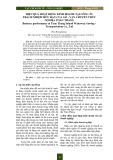
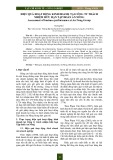
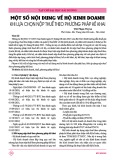
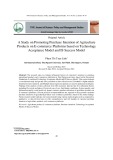




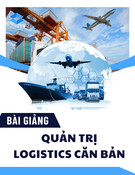
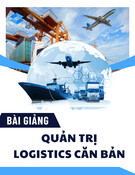
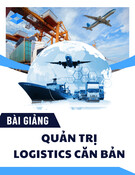
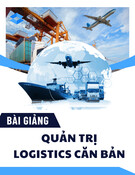

![Đề kiểm tra Quản trị logistics [mới nhất]](https://cdn.tailieu.vn/images/document/thumbnail/2025/20251015/2221002303@sv.ufm.edu.vn/135x160/35151760580355.jpg)
![Bộ câu hỏi thi vấn đáp Quản trị Logistics [năm hiện tại]](https://cdn.tailieu.vn/images/document/thumbnail/2025/20251014/baopn2005@gmail.com/135x160/40361760495274.jpg)
